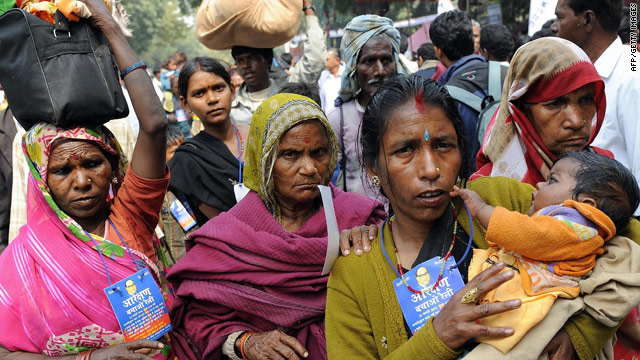
- One of India's low-caste communities has declared its own distinct religion
- Followers of 14-century spiritual figure now have own holy scriptures, flag and greeting
- Declaration made by Ravidass monastery whose priest's killing sparked protests in Punjab
- Five million Ravidassias from Punjab estimated to be spread across world
Followers of a 14-century spiritual figure, Guru Ravidass, will now have their own holy scriptures, a flag and a greeting, sect officials said.
The new holy book compiles Guru Ravidass' writings, which until now were predominantly found in sacred Sikh scriptures that the sect placed in its houses of worship.
The declaration was made by a key Ravidass monastery whose priest's killing in May last year in Vienna, Austria sparked furious protests in the Sikh heartland of Punjab.
Thousands of protesters from the low-caste communities -- called the Dalits, meaning the suppressed -- attacked road and rail transportation in the wake of the murder blamed on Sikh hardliners.
C.R. Suman, the manager of the Sachkhand Ballan monastery in Punjab state, told CNN that the announcement of a new Ravidassia faith was made on Saturday to a large congregation at the birthplace of the revered leader in Uttar Pradesh state.
Experts say the move was a response to social discrimination against low castes in Punjab, where close to 30 percent of the population is Dalit, the highest in any Indian state.
"The Ravidassias and other Dalits remain marginalized in Punjab, politically, religiously and economically," said author Balbir Madhopuri, who has written several books on the Hindu caste system.
Analysts say the declaration of a new faith is likely to be a psychological boost for Dalits in India. "They appear to have asserted themselves in a strategy that will give them a greater bargaining strength in their home state where power has centered around specific castes," said columnist Jaspal Singh Sidhu. "Outside of Punjab, it is likely to give a big psychological boost to other Dalit communities."
There are estimated about five million Ravidassias from Punjab now spread across the world, said Madhopuri.
Madhopuri, however, believes the new sacred text may not attract other Dalit communities because it only contains Ravidass verses.
"Yet, this announcement of a distinct religion is a symbol of Dalit assertion," he said.
According to Madhopuri, the last time the Dalits came together as a faith was in 1925 when the British ruled India. In the 1931 census, more than 450,000 registered themselves as members of the new Dalit faith called Ad Dharam, or Original Religion.
But the faith vanished after India's independence mainly because of what Madhopuri explained were lures of government jobs reserved for low-caste Hindus and Sikhs.
In India, Hindus make up more than 80 percent of its billion-plus population. Muslims constitute the second-largest religious group.
Sikhs, Buddhists, Jains and other faiths together form about 6 percent of remaining Indians.
After independence from the British in 1947, India outlawed what was an age-old practice of untouchability of low-caste Hindus by those seen as superior by birth.
Still, the communities are believed to be facing bias despite having being given quotas for government jobs.
India's crime statistics show that police registered more than 133,000 cases from 2004 to 2008 under the country's stringent laws to protect Dalits against atrocities.
The birth of a new religion in Punjab has had Sikhs worried the most, as it emerged in their state where the monotheistic faith was founded in the 15th century to break caste and religious distinctions.
The Shiromani Gurdwara Parbandhak Committee (SGPC), the top Sikh religious administration, termed the Ravidassia declaration unfortunate.
It disagrees that the practical Sikh response to the downtrodden did not match the Sikh faith's core beliefs of equality.
Untouchable groups
- Dalit, in India and Nepal
- Al-Akhdam in Yemen
- Burakumin in Japan
- Baekjeong in Korea
- Cagots in France
- Vaqueiros de alzada in Spain
- Madhiban in Somalia
- Gypsies throughout Europe
- Jews throughout Europe, including Marranos in Spain and Portugal and Xueta in Majorca
- Moriscos in Spain and Portugal
- Ragyabpa in Tibet (see Social classes of Tibet)
Cultural outgroups
- African Americans in the United States (and, in the 19th century, Irish, Chinese, and Japanese immigrants)
Dalits and religion
Reforms
Many Bhakti period saints rejected the caste discriminations and accepted all castes, including untouchables, into their fold. During the British Raj, this sentiment gathered steam, and many Hindu reform movements such as Brahmo Samaj and Arya Samaj renounced caste-based discrimination. Mahatma Gandhi called them "Harijans" (children of God) although that term is now considered patronizing and the term Dalit ("downtrodden") is the more commonly used. Gandhi's contribution toward the emancipation of the untouchables is still debated, especially in the commentary of his contemporary Dr. B.R. Ambedkar, an untouchable himself, who frequently saw Gandhi's activities as detrimental to the cause of upliftment of his people.
Daily Inspiration
February 2nd, 2010Hu Shih, former Ambassador of China to the United States












No comments:
Post a Comment